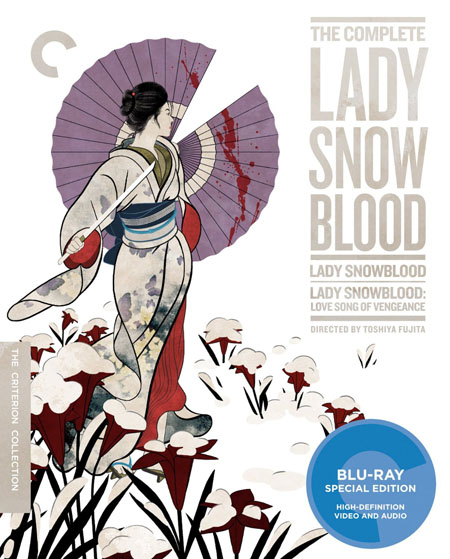
“WHITE SNOW, RED
BLOODâ€
By Raymond Benson
I’m
not sure how, when, and where Quentin Tarantino actually saw these two Japanese
films back in the day (they weren’t released in the U.S.), but the character of
a vengeful female samurai assassin was a major inspiration for the director’s Kill Bill pictures; in fact, Lucy Liu’s
character of O-Ren Ishii is so close to Lady Snowblood that it’s unclear if she’s
an homage or a rip-off. At any rate, if you’re a fan of Kill Bill, then you will most likely appreciate these low budget
cult action films.
Based
on a Japanese manga by Kazuo Koike
and Kazuo Kamimura (Shurayuki-hime)
published in 1972 and 1973, both features star the beautiful Meiko Kaji as Lady
Snowblood, a kimono-dressed assassin who is active in the late 19th Century and
wields a mean blade hidden in an umbrella. Kaji is a popular actress in her
native country—she appeared in many B-movie action and martial arts pictures (i.e.,
the Japanese equivalent of exploitation movies) in the 70s, and then went into
television in the 80s. She is also an accomplished musical artist and singer,
having released many singles and a dozen LPs. She sings the main title song of Lady Snowblood (“Shuro No Hanaâ€), and Tarantino used the same theme during a
sequence in Kill Bill, Vol. 1. Meiko
Kaji is perhaps the best reason to view this double feature.
The
first film is an origin story in which we learn that Yuki, aka Lady Snowblood, is
born to a mother who is in prison for killing one of a criminal foursome—three
men and one woman—who murdered her husband and son, and raped her. She passes
on the remainder of her vendetta to her daughter, who grows up to study martial
arts and become a vigilante. As an adult, Yuki tracks down the other three to
exact her revenge.
The
second picture finds Yuki as something of a hired hand of the secret police.
She must infiltrate the home of an anarchist in order to retrieve an item the
government wants—but, of course, her prey turns out not to be the true bad guy.
Lady Snowblood must switch allegiances and set things right with a lot of
swordplay, blood-letting, and Eastern-style poise.

The
movies are colorful and exotic in terms of photography, production design, and
costumes—the imagery of white snow splashed with red blood, mixed with the
period Japanese wardrobe and sets, exhibit a unique beauty that Tarantino
recreated in Kill Bill. Otherwise, the
two Snowblood movies are cheaply
done. The blood effects are, for the most part, ridiculous. One slash of a
throat and the blood laughably sprays like
a fire hose. The storylines are predictable, but like the manga from which they are adapted, are pure comic book pulp.
The
Criterion Collection presents both features on one disk. The new 2K digital
restorations look very good in that glorious and vividly garish color that is indicative
of the 70s. Each film has uncompressed monaural soundtracks, and there are new
English subtitle translations. The disk is short on supplements, containing
only new interviews with Kazuo Koike (the writer of the manga), and screenwriter Norio Osada. Trailers for both pictures
are included. The booklet features an essay by critic Howard Hampton.
Recommended
for aficionados of Japanese exploitation and martial arts fare, which, in the
1970s, was the equivalent of fast food.
CLICK HERE TO ORDER FROM AMAZON